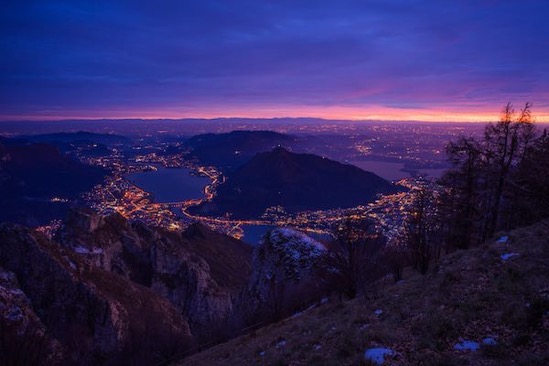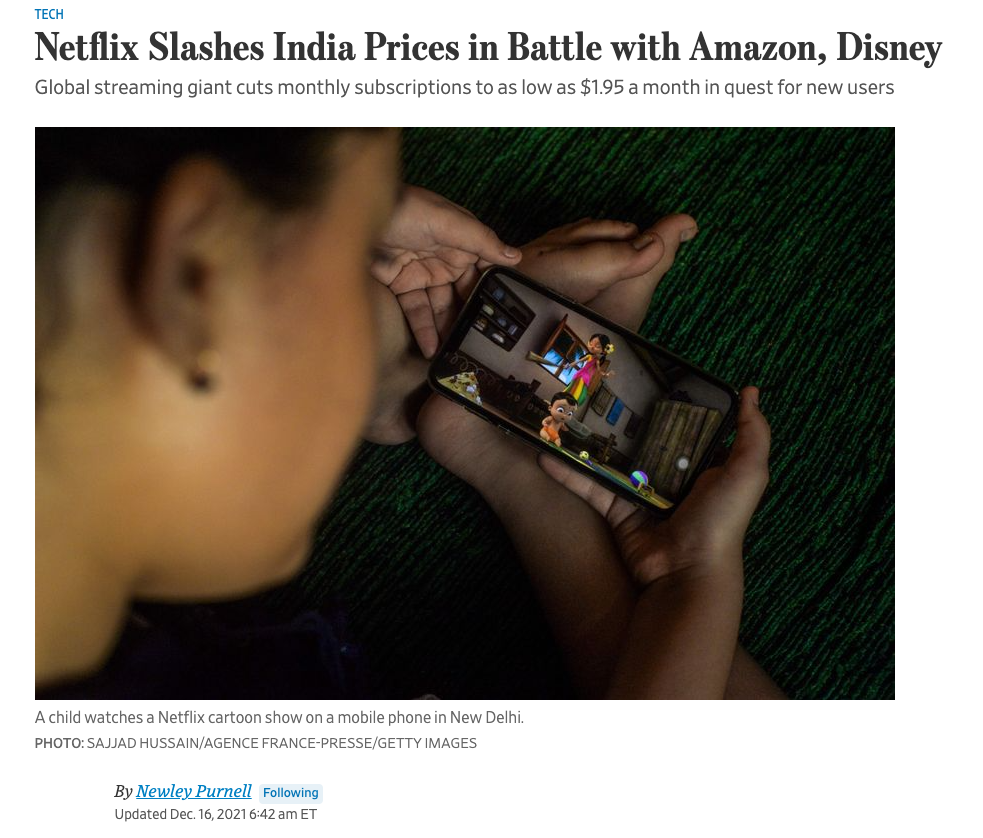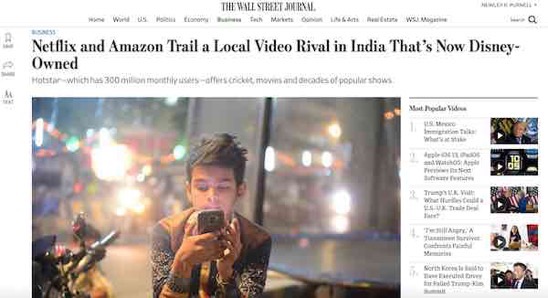
Hi, friends. Welcome to the latest edition of Newley’s Notes.
🆕 My latest story, which came out Tuesday, is about the streaming video wars here in India.
🎥 The headline: Netflix and Amazon Trail a Local Video Rival in India That’s Now Disney-Owned. It begins:
To win in India, home to many of the world’s next billion internet users, Netflix Inc. and Amazon.com Inc. are copying the tactics of a video-streaming service built for the local market.
Hotstar dominates the Indian market. Launched four years ago by media conglomerate Star India as a mobile-first streaming platform for watching cricket, movies and TV, it now has 300 million monthly users – roughly 10% more than YouTube, India’s second-biggest video content platform. While only three million users pay for access, that is still more than Amazon has, and more than twice as many as Netflix. Walt Disney Co. now owns Hotstar.
Netflix and Amazon, shut out of China and facing stiff competition in the maturing U.S. market, are adopting the strategies that fueled Hotstar’s success – low prices that the average Indian viewer can afford and loads of local content in multiple Indian languages.
Click through to read the rest.
Here are ten items worth your time this week:
🔒 1) Apple Touts New Privacy Features Amid Scrutiny of Tech Giants [WSJ]
My colleague Tripp Mickle reports from Apple’s annual software developers’ conference:
“Apple Inc. sought to tout itself as a digital-privacy crusader with an anonymous login system and tools that prevent apps from tracking a user’s location, a push that is designed to further differentiate it from Google and Facebook Inc., which have built their fortunes on tracking user activity and behavior.”
🍎 Other new Apple stuff, via my colleague David Pierce:
- There’s a new iPad OS
- The iPad is getting copy-and-paste, and thumb drive capability
- Mac is retiring the iTunes app
- Apple Watch is getting an app store
- There’s a new Mac Pro starting at…$6,000
🚫 2) YouTube just banned supremacist content, and thousands of channels are about to be removed [The Verge]
“YouTube is changing its community guidelines to ban videos promoting the superiority of any group as a justification for discrimination against others based on their age, gender, race, caste, religion, sexual orientation, or veteran status, the company said today. ”
🎙️ 3) Related: The Making of a YouTube Radical [New York Times]
“The radicalization of young men is driven by a complex stew of emotional, economic and political elements, many having nothing to do with social media. But critics and independent researchers say YouTube has inadvertently created a dangerous on-ramp to extremism by combining two things: a business model that rewards provocative videos with exposure and advertising dollars, and an algorithm that guides users down personalized paths meant to keep them glued to their screens.”
🌊 4) Towing an Iceberg: One Captain’s Plan to Bring Drinking Water to 4 Million People [Bloomberg Businessweek]
“Making use of his unusual skill set, he plans to harness and tow an enormous Antarctic iceberg to South Africa and convert it into municipal water.”
🌷 5) Post-it note war over flowers deemed ‘most middle-class argument ever’ [Metro]
“The row, which kicked off on a street in London, first began after someone left a note on a tree simply stating ‘please don’t pick my flowers’.”
📱 6) When Grown-Ups Get Caught in Teens’ AirDrop Crossfire [The Atlantic]
“As more teens get their own iPhones and a rising number of schools crack down on social media, AirDrop culture has gone mainstream – and more adults are getting caught in the crossfire.”
✂️ 7) The cutting-edge of cutting: How Japanese scissors have evolved [Nikkei Asian Review]
“Inside Tokyo stationery stores, scissors are undergoing a quiet evolution.”
🧵 8) Complete Knot List [Animated Knots]
“Follow along as ropes tie themselves, showing just the essential steps, so you can master a knot in no time.”
📻 9) Learning to Listen, in a Los Angeles Cafe Built for Vinyl [New York Times]
“Japanese-style listening bars, where D.J.’s spin carefully selected records for a hushed audience, are arriving in America.”
😂 10) Sometimes dogs just wanna play…at the most inappropriate times. [Instagram: dogsvideos1]
💡 Quote of the week:
“For every minute you are angry you lose sixty seconds of happiness.” – Ralph Waldo Emerson
💥 Was this message forwarded to you? Sign up here.
👊 Fist bump from New Delhi,
Newley



 I really enjoyed the new Netflix docu-series “
I really enjoyed the new Netflix docu-series “